
Piedra de nacimiento de enero: Comenzando el año con granate
Si tu cumpleaños marca el inicio del año, te alegrará saber que la piedra natal de enero es el granate. Enero es el mes de los nuevos comienzos y las perspectivas positivas sobre el futuro; el granate también refleja esta luminosidad y la amplitud de posibilidades.
El nombre de enero deriva de Jano, el dios del comienzo y el fin en la mitología romana. Jano tiene dos caras, cada una mirando hacia el pasado o el futuro.
En ese sentido, analizaremos el granate, la piedra natal tradicional de enero, con sus diversos significados, historia y usos. También presentaremos algunas alternativas modernas que puedes llevar contigo para celebrar tu nacimiento en enero.
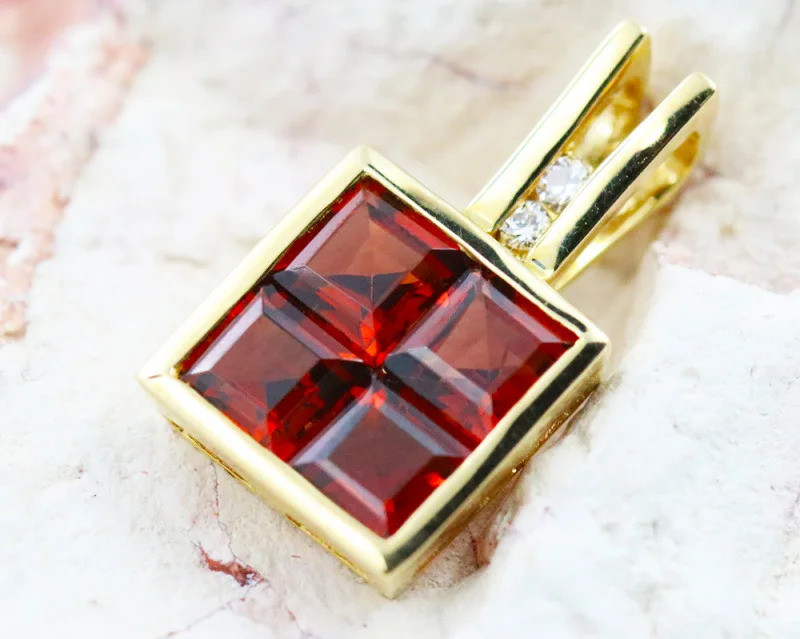
Significado de la piedra natal de enero: Simbolismo del granate
Comenzando con el simbolismo, el granate, piedra de nacimiento de enero, generalmente representa amistad, calidez y pasión.
Otro significado de esta piedra semipreciosa de enero es el de protección, un uso que se remonta a tiempos antiguos.
Importancia histórica y cultural del granate, piedra natal de enero
La piedra de nacimiento de enero es la más famosa por su color rojo brillante, pero también viene en varios tonos, desde rosa o naranja hasta verde o morado.
El granate también sirve como la piedra preciosa tradicional del segundo aniversario de bodas .
El nombre “granate” deriva del término latino medieval granatus , que significa “granada” porque los pequeños cristales de granate rojo se parecen a las semillas de granada.
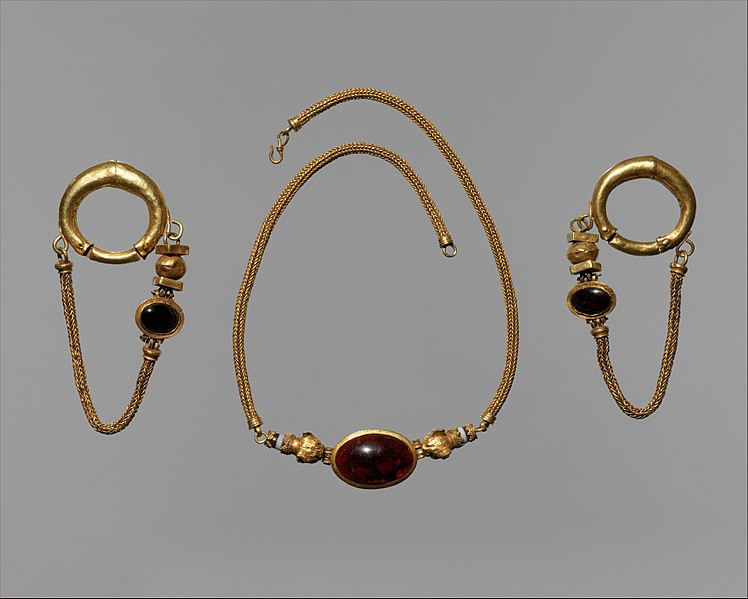 En la imagen superior: collar y pendientes de granate y ágata griegos del siglo I a. C. | Crédito de la imagen: Museo Metropolitano de Arte , dominio público
En la imagen superior: collar y pendientes de granate y ágata griegos del siglo I a. C. | Crédito de la imagen: Museo Metropolitano de Arte , dominio público
Los granates en la antigüedad
Los usos registrados del granate se remontan a la Edad de Bronce (alrededor del 3300 a. C. al 1200 a. C.), cuando esta piedra natal de enero se utilizaba en abrasivos, entierros y joyería real. Los antiguos también usaban el granate como talismanes para protegerse en la guerra y los viajes, creyendo que la gema traería luz a la oscuridad.
Los antiguos faraones egipcios usaban collares de granates rojos tanto en vida como en muerte, y eran enterrados con estas piedras natales de julio. Los egipcios creían que los granates simbolizaban la vida.
En la antigua Roma , los funcionarios sellaban los documentos con anillos de sello de granate tallado. Los romanos, al viajar, ir a la batalla o evitar enfermedades como la peste, usaban granate como protección.
Un antiguo mito griego sobre los orígenes del granate involucra a Perséfone, la diosa de la vegetación, famosa por haber sido tomada y casada con Hades, dios del inframundo.
Cuando Zeus le ordenó a Hades que devolviera a Perséfone, Hades le dio una granada. Al comer las semillas de la granada, quedó unida a Hades eternamente, pasando la mitad del año (de otoño a invierno) en el inframundo.
Como tal, las granadas y granates de aspecto similar se asociaban con los amantes separados, la eternidad y los ciclos regenerativos de la Tierra.
Nombres antiguos de los granates
Antes de “granate”, otros términos antiguos para los granates (y piedras preciosas rojas similares) incluían:
El término griego ántrax (del filósofo griego Teofrasto), que significa “brasa incandescente”
El término latino carchedonius (del escritor romano Petronio), del nombre griego Carchedonia para Cartago, una antigua ciudad fenicia.
El raktamani sánscrito e hindú, que significa “joya preciosa de color rojo sangre”.
Los términos latinos carbunculus o carbuncle (del erudito romano Plinio el Viejo), que significan “carbón ardiente”
Muchos de los primeros nombres del granate hacían referencia a sus cualidades ardientes: color rojo, brillo y resistencia al calor.
Sin embargo, en la antigüedad, muchas piedras rojas se llamaban "carbuncos", por lo que es difícil saber si realmente eran granates. Hoy en día, a los cabujones de granate rojo todavía se les llama a veces carbuncos.
 En la imagen superior: Anillo de granate ostrogótico (germánico de la época romana) del siglo V (alta edad media) con tramado grabado | Crédito de la imagen: Museo de Arte Walters, dominio público
En la imagen superior: Anillo de granate ostrogótico (germánico de la época romana) del siglo V (alta edad media) con tramado grabado | Crédito de la imagen: Museo de Arte Walters, dominio público
Significado religioso y espiritual
El granate, piedra de nacimiento de enero, tiene varios significados religiosos o espirituales y propiedades curativas.
Cristianismo :
La Biblia hace referencia al granate, interpretado a partir de la palabra hebrea nophek , en adornos clericales o reales y como un faro de luz guía en el Arca de Noé.
Algunos eruditos bíblicos interpretaron estas menciones de granates, destacando el color sangre de la gema y su capacidad de brillar en la oscuridad, para simbolizar el sacrificio de Jesucristo, la palabra divina de Dios, la devoción a Dios o la espiritualidad cristiana en general.
Los clérigos de la Edad Media (alrededor del 475 al 1450 d. C.) solían usar piedras preciosas de granate. Los anillos de los obispos católicos representaban su autoridad religiosa y su "matrimonio" simbólico con la Iglesia.
Algunos eruditos cristianos incluso afirmaron que la ingestión de carbuncos en polvo otorgaría poderes, juicios honorables y despertar espiritual.
Paganos :
Los paganos francos como Childerico I creían que las gemas rojas como los granates simbolizaban el amor, la vida y la fertilidad, y las utilizaban para tallar imágenes de dioses como Eros, Freia e Isis.
Islam :
El Corán menciona siete cielos en el más allá, y el sexto cielo está hecho de granates y rubíes. En el Corán, las piedras preciosas a menudo simbolizaban las bendiciones de Alá.
Hinduismo :
Los sanadores energéticos hindúes utilizan el granate como piedra para el chakra raíz o corona. Los astrólogos védicos también asocian el granate rojo con «Rahu» o Marte, el planeta de la energía y la guerra, creyendo que los granates contrarrestan los efectos negativos de Marte.
En general, los granates tenían muchos significados, tanto curativos como dañinos.
Algunas tribus nativas americanas y asiáticas usaban granates rojos como balas para asegurar daños fatales, mientras que los médicos medievales trataban diversas dolencias con granates, incluidas fiebres, heridas, ictericia e incluso la peste bubónica.
Geología y composición del granate de enero
Los granates son un grupo extenso y complejo de minerales con un árbol de categorías. Las dos series principales de granates con calidad gema son la piralspita y la ugrandita:
Piralspita : Silicatos ricos en aluminio; Contiene las especies piropo , almandino y espesartita.
Ugrandita : Silicatos ricos en calcio; Contiene las especies uvarovita , grosularia y andradita.
Muchas variedades de granate son mezclas de esas especies, a menudo dentro de la misma serie pero a veces entrecruzadas entre series.
Repasemos primero las especies de piralspita de estas piedras de nacimiento de enero.
Piropo
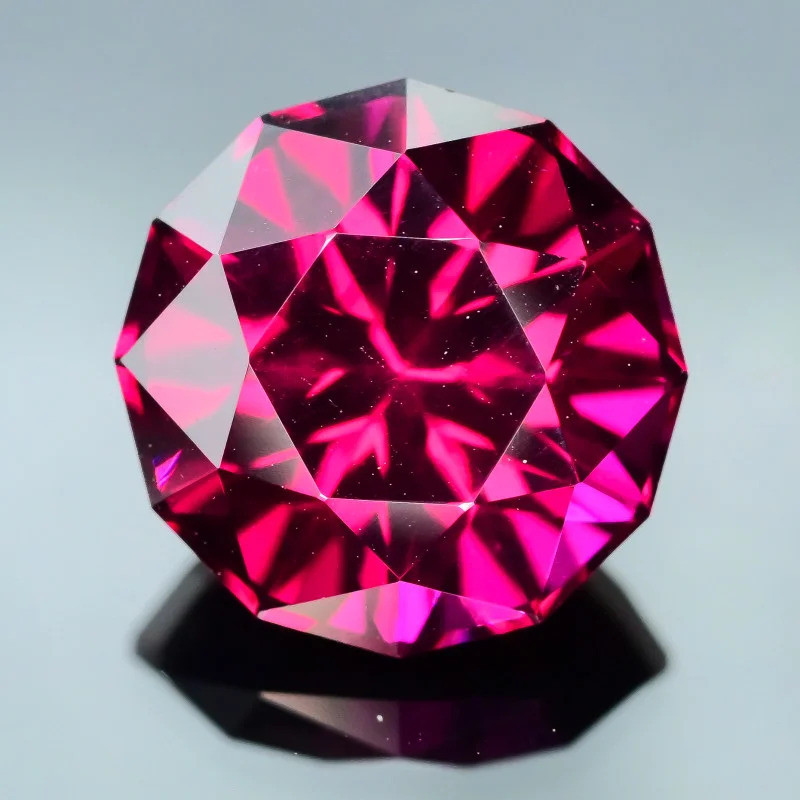 En la imagen de arriba: Granate umbalita facetado de Mozambique.
En la imagen de arriba: Granate umbalita facetado de Mozambique.
Los granates piropos, la variedad más conocida del granate rojo, son silicatos de magnesio y aluminio, populares por su color rojo sangre o granada. Los piropos son los únicos granates de color rojo uniforme, aunque sus tonos exactos varían con matices púrpura, naranja, negro y marrón.
Las variedades de piedras de nacimiento de piropo incluyen:
Piropo cromado
Piropo pastel
Granates de Mozambique
Granate estrella
Umbalita
Granate uva
Almandina
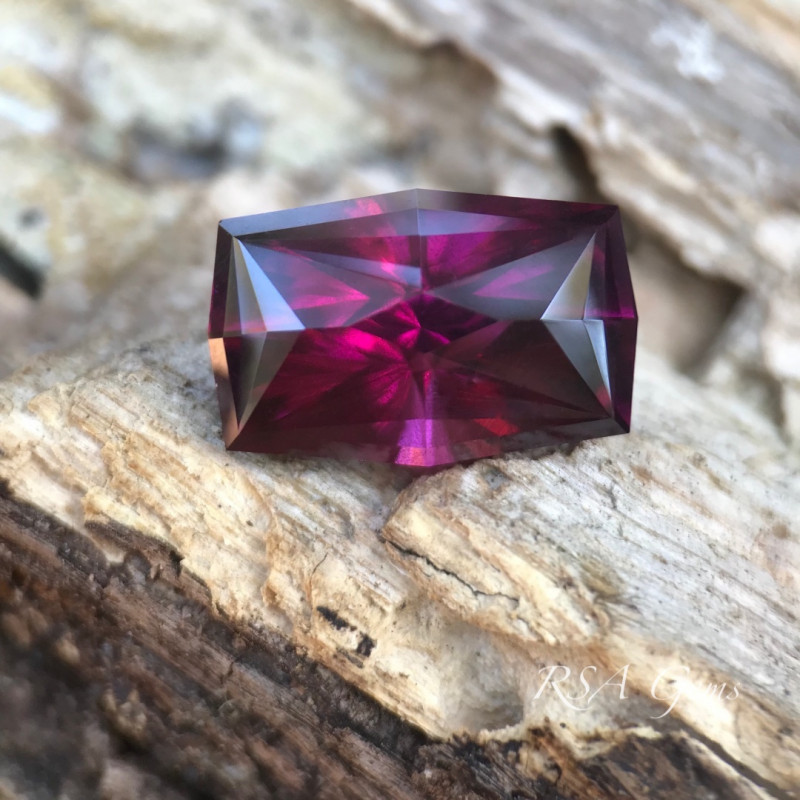 En la imagen de arriba: Granate rodolita facetado.
En la imagen de arriba: Granate rodolita facetado.
El almandino es otra variedad de granate muy popular. Este silicato de hierro y aluminio es ligeramente más duro que el piropo. Sus colores varían desde rojos intensos y rojos violáceos hasta tonos más marrones.
Las variedades de almandino incluyen:
Granates de Mozambique
Rodolita
Granate Malaya (Malaia)
Granate estrella
Umbalita
Granate uva
Granate Proteo
Espesartina
 En la imagen de arriba: Granate mandarín facetado
En la imagen de arriba: Granate mandarín facetado
Los granates espesartitas son la especie de piralspita más singular, conocida por su coloración entre amarilla y naranja y su gran brillo. Las variedades de este silicato de aluminio y manganeso incluyen:
Granate Malaya (Malaia)
Cachemira
Granate espesartita ojo de gato
Umbalita
¡Ahora nos adentraremos en la especie ugrandita!
Uvarovita
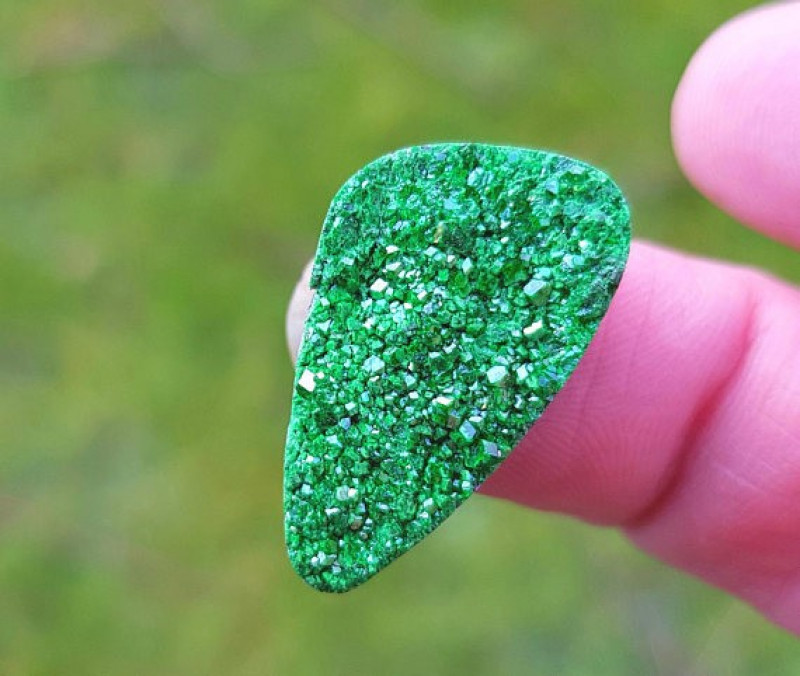 En la imagen de arriba: drusa de granate uvarovita
En la imagen de arriba: drusa de granate uvarovita
La uvarovita es un silicato de calcio y cromo, y la especie de granate con calidad gema más rara. Además, es el único granate que presenta un verde uniforme, con tonos que van de medios a oscuros.
Grossular
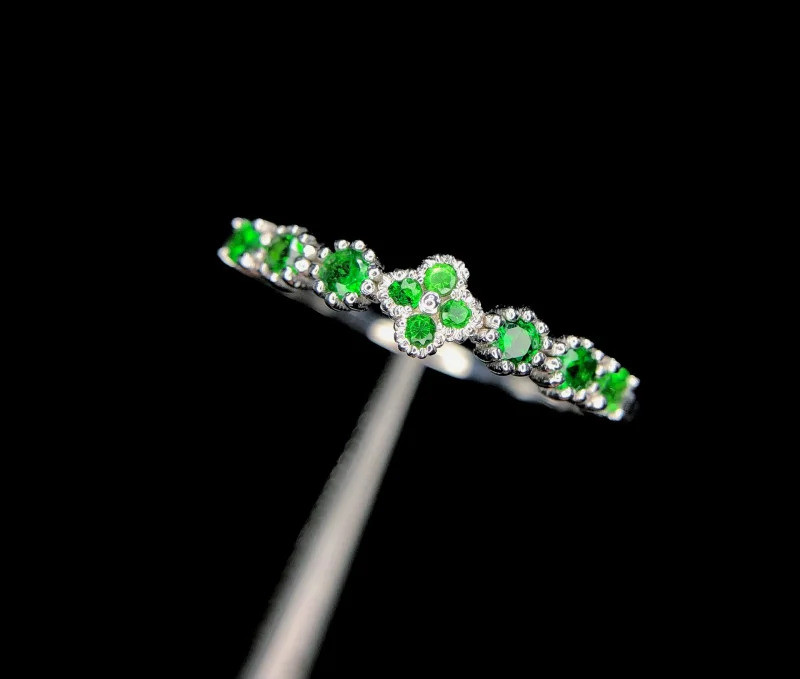 En la imagen de arriba: Anillo de plata con granates tsavoritas verdes y circonitas cúbicas.
En la imagen de arriba: Anillo de plata con granates tsavoritas verdes y circonitas cúbicas.
Los granates grosularia son silicatos de calcio y aluminio, en los que el hierro a veces sustituye parte del calcio y el aluminio. Son conocidos por tener la gama más amplia de colores y ser las únicas variedades incoloras con calidad de gema.
Las variedades de granate grosularia son:
Granate imperial
Granate menta (o menta Merelani)
Granate Leuco
Umbalita
Algunos consideran que el granate hidrogrosular es una variedad grosularia, pero esto es motivo de debate entre los gemólogos.
Andradita
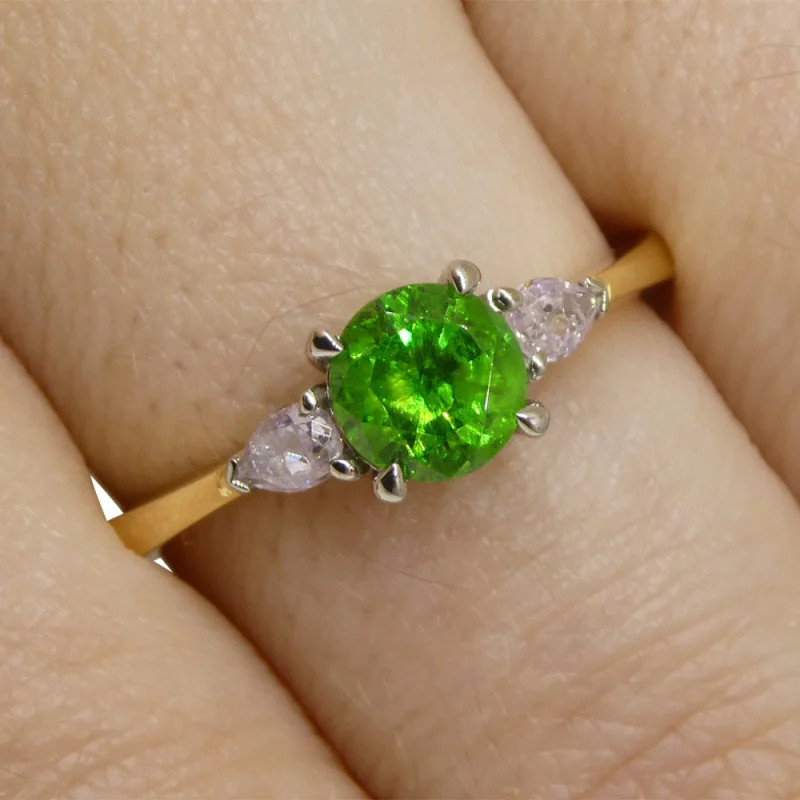 En la imagen de arriba: Anillo de oro con granate demantoide verde y diamantes rosas.
En la imagen de arriba: Anillo de oro con granate demantoide verde y diamantes rosas.
Las andraditas son silicatos de hierro y calcio con una dispersión (destellos coloridos) y un brillo (destellos de luz blanca) excepcionalmente altos. Aunque no son tan populares ni más raras que otras especies, existen variedades muy codiciadas, como:
Colofonita
Granate arcoíris
Topazolita
Granate de Mali
¡Todas estas variedades contribuyen al hermoso arcoíris de colores granates y efectos ópticos presentes en estas piedras de nacimiento de enero!
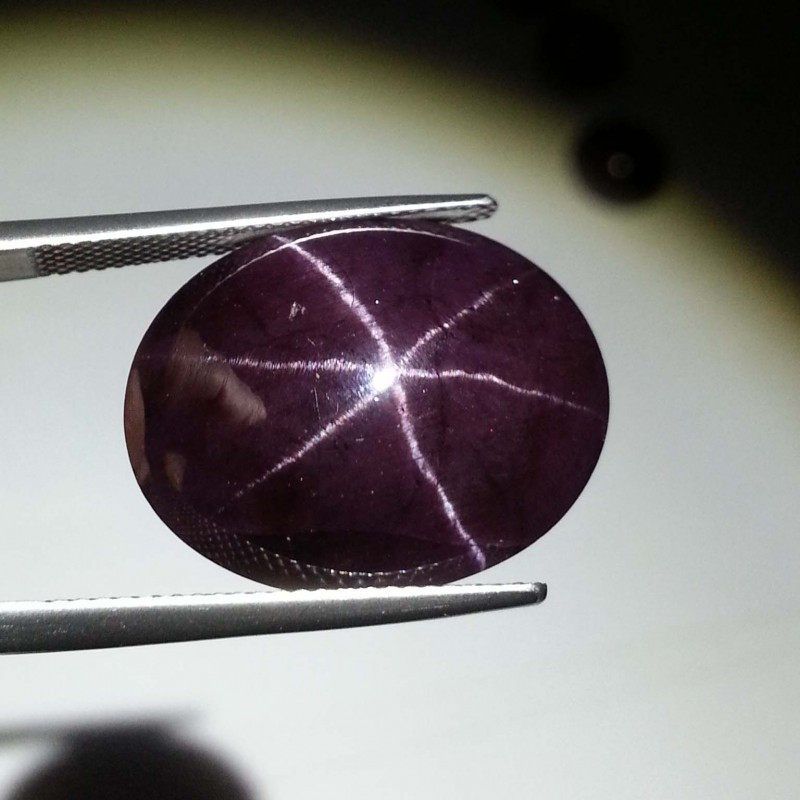 En la imagen de arriba: Granate estrella púrpura
En la imagen de arriba: Granate estrella púrpura
Colores y variaciones cautivadores
¿De qué color es la piedra natal de enero? El granate es el más popular, el rojo, pero en realidad existe en una amplia gama de colores, y algunas variedades incluso tienen efectos ópticos especiales.
Granates por color
El color de la piedra de nacimiento de enero puede ser prácticamente cualquier tono, aunque el azul es extremadamente raro y solo está presente en algunas variedades que cambian de color.
Las variedades más populares para cada color de esta piedra de nacimiento de enero son:
Rojo : Piropo
Naranja : Mandarina Granate
Amarillo : granate de Mali
Verde : Demantoide o tsavorita
Púrpura : Umbalita o granate uva
Rosa : Rodolita
Incoloro : Sólo granates leuco (grosularia)
Negro : melanita
Además de variar los colores, las piedras de nacimiento de enero de color granate también están disponibles con efectos ópticos únicos.
Granates ópticamente fenomenales
Las piedras de nacimiento de granate con fenómenos ópticos incluyen:
Granate estrella : muestra una "estrella" de 4, 6 o incluso 12 rayos de luz reflejada a través de un asterismo; generalmente negro, marrón o rojo violáceo oscuro, pero puede tener varios tonos de rojo a púrpura, incluidos el negro rojizo y el púrpura negruzco.
Granate ojo de gato : refleja un rayo de luz parecido al ojo de un gato a través de chatoyancia debido a inclusiones paralelas de fibras con forma de aguja o tubos huecos; siempre espesartita
Granate que cambia de color : cambia de color con diferentes tipos de iluminación, generalmente UV (luz solar) y luz incandescente; generalmente de rojo a morado o de rojo a verde; los más valiosos son de azul a rojo o morado.
Además de su aspecto fenomenal, los granates también poseen propiedades curativas fenomenales.
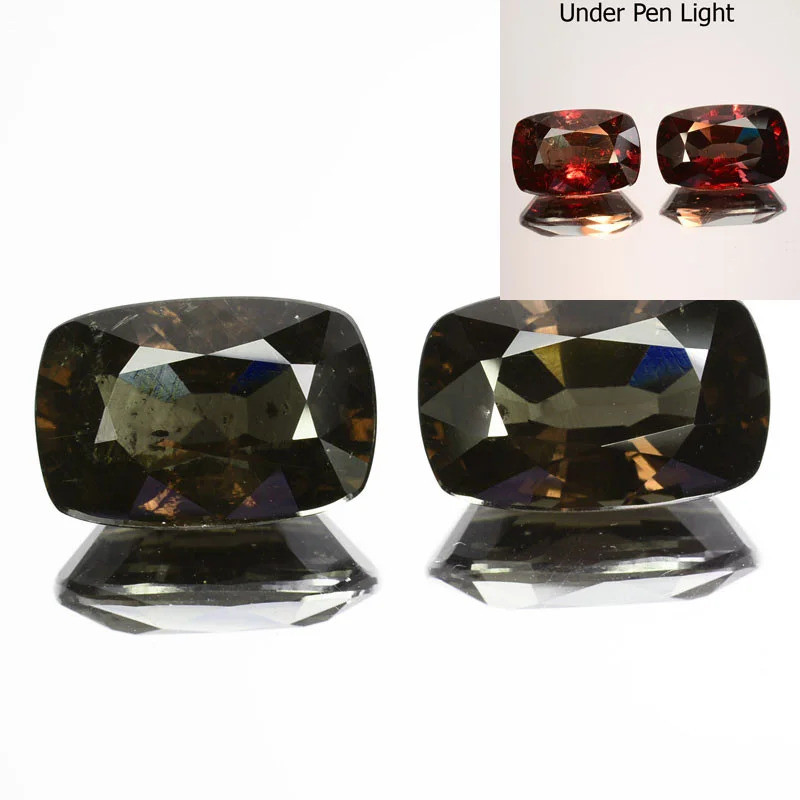 En la imagen de arriba: Granates facetados que cambian de color.
En la imagen de arriba: Granates facetados que cambian de color.
Propiedades metafísicas del granate
El uso de la piedra de nacimiento de enero como piedra curativa ha persistido desde la antigüedad hasta las prácticas modernas de curación con cristales.
Muchos de los usos metafísicos del granate están relacionados con sus asociaciones con la sangre y el corazón, símbolos de vida, fuerza y amor.
Físicamente, se dice que las piedras de nacimiento de granate mejoran la circulación sanguínea, fortalecen el corazón y limpian el cuerpo de toxinas, como lo hace la sangre real en nuestros cuerpos.
En la curación energética, los granates se utilizan para equilibrar todos los chakras , permitiendo que la energía fluya libremente por todo el ser físico, espiritual y emocional.
Emocionalmente, se dice que el granate, piedra de nacimiento de enero, aumenta:
Confianza
Pasión
Determinación
Fertilidad
Resiliencia
Aquellos que tienen una relación pueden beneficiarse de las supuestas habilidades del granate para ayudarlos a sentirse más cómodos siendo vulnerables, liberar sentimientos negativos como el resentimiento o la ira y aumentar los sentimientos de pasión por el otro.
Piedras del zodiaco para enero
Dos signos astrológicos caen bajo el período de piedra natal de enero: Capricornio del 22 de diciembre al 19 de enero y Acuario del 20 de enero al 18 de febrero.
El simbolismo del granate en la amistad, la calidez y la pasión coincide con su uso como piedra de nacimiento de Acuario. Se dice que los Acuario, signo de aire, son personas humanitarias apasionadas que valoran la amistad y la construcción de comunidades.
Los granates también pueden simbolizar la confianza y la devoción, romántica o no, y se les conoce con el apodo de "Piedra del Compromiso". Esto se relaciona mejor con el granate como piedra de nacimiento de Capricornio. Los Capricornio son líderes devotos y confiables, tanto en el trabajo como en casa.
Además del granate, hay algunas otras piedras natales de enero que vale la pena conocer.
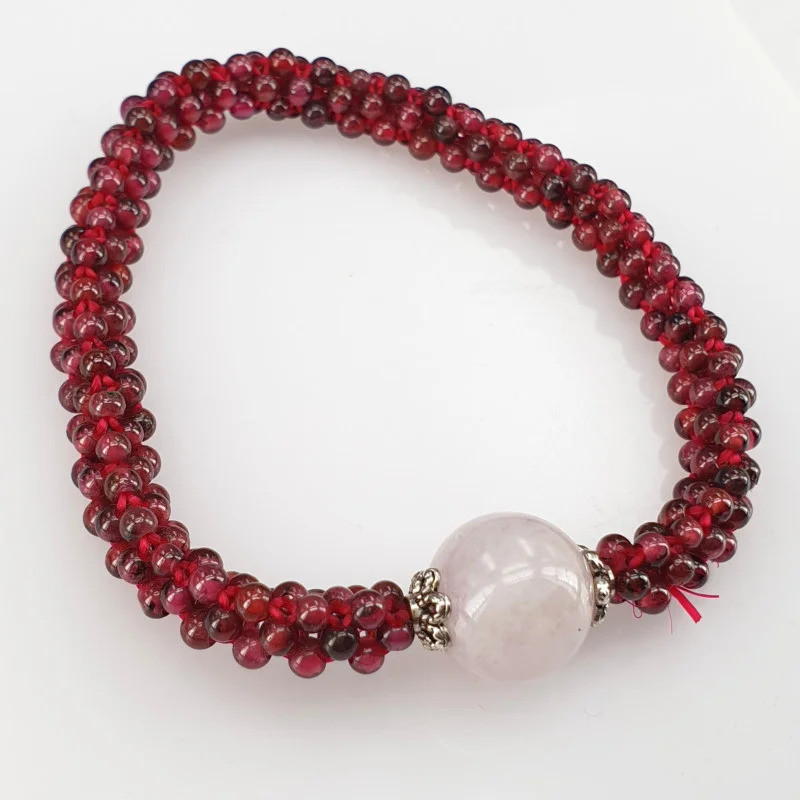 En la imagen de arriba: Pulsera de cuentas con cuarzo rosa y granates rojos.
En la imagen de arriba: Pulsera de cuentas con cuarzo rosa y granates rojos.
Piedras natales alternativas de enero
El color de piedra de nacimiento más común para enero es el rojo o alguna variación del mismo, como el rosa o el morado.
La principal alternativa al granate como piedra de nacimiento de enero es el cuarzo rosa , un complemento más suave al fuego del granate. Esta variedad de cuarzo rosa suele ser lechosa y translúcida. Esta alternativa también simboliza el amor y la aceptación universales.
La mística piedra de nacimiento de enero, según la astrología tibetana, es la esmeralda . Aunque notablemente diferente, con tonos verdes en lugar de rojos, las esmeraldas, como piedras de nacimiento de enero, reflejan el simbolismo del crecimiento personal y el renacimiento asociado con el año nuevo.
En comparación con el granate, el cuarzo rosa es menos duradero, pero está más disponible. Ambas piedras forman una excelente combinación en la joyería con la piedra natal de enero.
La esmeralda suele ser más duradera que el granate, pero a menudo más cara y con menor claridad .
Regalos personalizados con la piedra de nacimiento de enero
Aunque algunos consideran la idea de las piedras de nacimiento como una mera estrategia de marketing, estas tienen una larga historia de importancia. De hecho, la idea de las piedras de nacimiento por mes se remonta a textos bíblicos.
Las piedras de nacimiento suelen ser los primeros cristales con los que la gente se familiariza. Se cree que brindan protección y suerte a quien las usa, pero en un plano menos espiritual, las piedras de nacimiento son una celebración de la vida.
Ya sea que compre sus propias piedras de nacimiento o se las regale a un ser querido, hay varias formas de usar las piedras de nacimiento de enero:
Como collar o pendientes de una sola piedra preciosa
En joyas con la(s) piedra(s) de nacimiento de un ser querido
En gemelos
Como parte de un conjunto de anillos apilados
Adornando una placa con nombre personalizada
Como decoración de habitación de cristal tallado (o crudo)
¡La lista es interminable, así que sé creativo! Al fin y al cabo, es tu piedra de nacimiento, así que úsala como quieras.
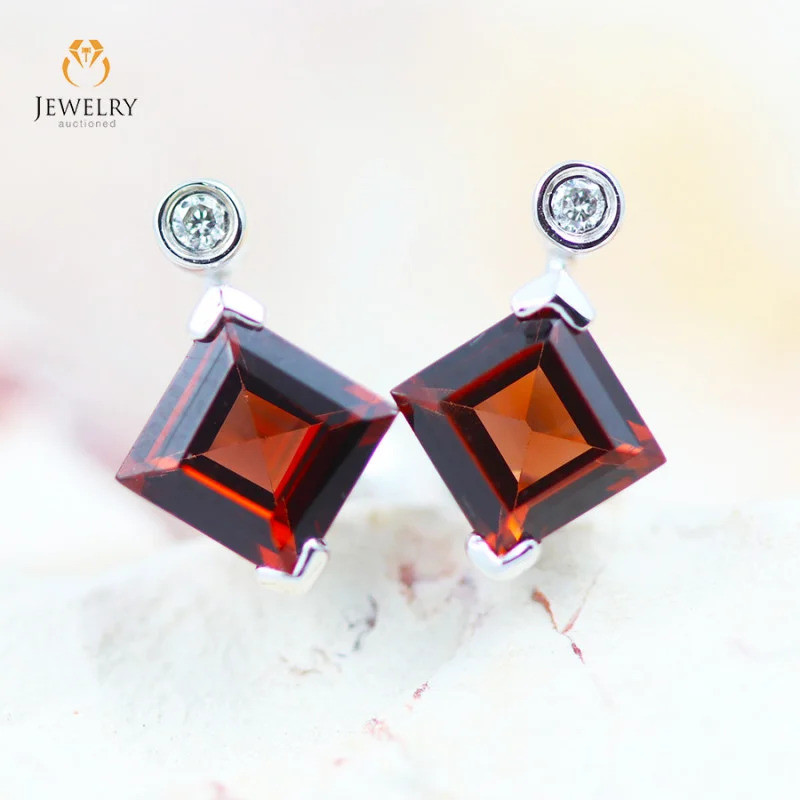 En la imagen de arriba: Pendientes de oro blanco con granates rojos y diamantes blancos.
En la imagen de arriba: Pendientes de oro blanco con granates rojos y diamantes blancos.
¡Celebre su nuevo yo con las piedras de nacimiento de enero!
Si naciste en enero, sabes que brillas como el motor del año y un reflejo del futuro. ¡Tu piedra de nacimiento también debería reflejarlo! Ya sea que elijas el atemporal y encantador granate o una alternativa como el cuarzo rosa, lo importante es que tengas una piedra de nacimiento que te celebre.
Buscar en el Gemstone Encyclopedia
Subastas relacionadas
Artículos relacionados
Las esmeraldas Gota de Aceite tienen una característica especial que aumenta su valor. Lea más sobre este raro tipo de esmeralda y descubra cómo aumenta su valor.
9th May 2018
El jade es una hermosa piedra que puede tener muchos colores, como verde, naranja o blanco. Aprende a probar el jade para comprobar su autenticidad.
9th May 2018
La cornalina es un mineral de calcedonia famoso por sus intensos colores naranjas. ¡Aprenda todo sobre el significado, la historia y las propiedades de la cornalina en esta práctica guía!
26th Feb 2021
últimos artículos
Descubra la historia, las propiedades, el valor y los consejos de cuidado de la piedra de sangre de pollo, una piedra preciosa rara y vibrante apreciada por sus llamativos patrones rojos y su importancia cultural.
8th Dec 2025
La gaylussita es un mineral raro, utilizado principalmente en la industria, ya que se enturbia fácilmente al deshidratarse. Descubra la historia, las propiedades, los usos y las características de la gaylussita en esta guía completa.
7th Dec 2025
La chiolita es un mineral raro, de incoloro a blanco, emparentado con la criolita. Las gemas son muy escasas y solo se encuentran en un par de lugares. Descubra aquí los usos, la historia, los precios y las características de la chiolita.
5th Dec 2025
Categorías de artículos
How To's is where you will find helpful articles from gem Rock Auctions on how to cut gemstones, select gemstones and buy gemstones.
9 Artículos




